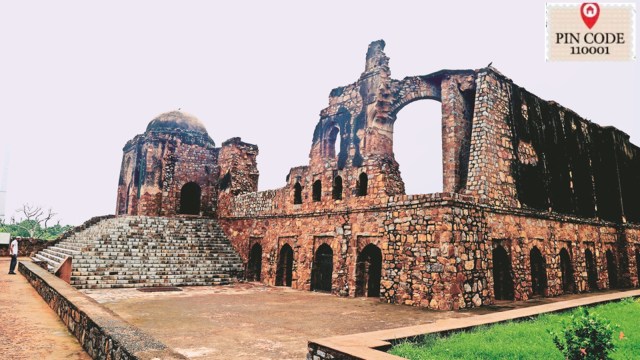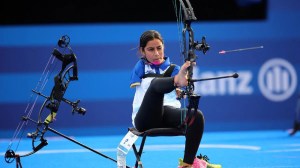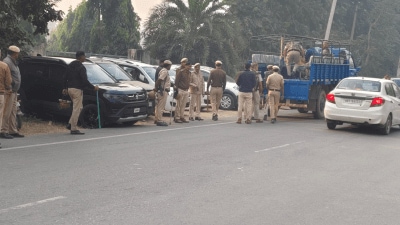A riverside citadel, symbol of a king’s ambitions: Feroz Shah Kotla, where ruins tell a story
A short walk from the stadium leads to a 14th-century monument built by Firoz Shah Tughlaq, ruler of the Tughlaq dynasty who succeeded his cousin Muhammad bin Tughlaq.
 The mosque inside the complex. (Express Photo by Amit Mehra)
The mosque inside the complex. (Express Photo by Amit Mehra)From Sunil Gavaskar’s record-equalling test century in 1983 to Anil Kumble’s thrilling 1999 outing that saw him clinching all 10 wickets against Pakistan, some of Indian cricket’s most iconic moments have been witnessed at the Feroz Shah Kotla stadium, which was later renamed Arun Jaitley Stadium. While the stadium has seen some historic moments, its first name is a reminder of India’s rich history — the stories of which have been passed from one generation to another.
A short walk from the stadium leads to a 14th-century monument built by Firoz Shah Tughlaq, ruler of the Tughlaq dynasty who succeeded his cousin Muhammad bin Tughlaq.
“The way the Kotla (fortress) is now is no indicator to how grand and sprawling the premises once were,” Author and Filmmaker Sohail Hashmi tells The Indian Express. “This was once a part of the larger city of Firozabad (the fifth city of Delhi), extending up to Northern Delhi Ridge on one side and beyond the Purana Qila on the other,” he adds.
Rana Safvi writes in her book The Forgotten Cities of Delhi: “It was used as a prototype for later Mughal fortresses as this is the first time the concept of a Diwan-e-Aam for the public and a Diwan-e-Khas for the nobles was introduced.”
With a vast expanse of ruins all around, it is difficult to imagine how the structures were in their heyday. “When Shahjahanabad (the seventh city of Delhi) was built, stones from Feroz Shah Kotla were used in building the 7-km-long wall around it. Kotla was cannabalised, the way it had cannabalised older cities such as Siri, Mehrauli and Tuglaqabad when it was built.”
Nevertheless, there are structures that still retain some of their original shape, such as the baoli, and parts of an imposing mosque, accessed through a flight of broad, ash-coloured stairs.
“The mosque is said to have been built by Junan Shah Telangani, the Prime Minister of Firoz Shah Tughlaq,” says Hashmi.
Writes Safvi: “The mosque has been designed in such a way that the entrance door faces the north and not east as was the norm in mosques. This is because, the Yamuna flows on the east side, very close to its eastern walls.”
A distinctive structure at the citadel is a pillar, towering over all other structures and serving as a testament to the ruler’s scale of ambition. This is Ashoka’s Pillar, one of the two Firoz Shah Tughlaq came across during his travels and ordered to be brought to Delhi.
This author remembers seeing the pillar up close after a steep climb, passing through dark, labyrinthine mass that made its lower floors, during her visit in 2018. However, after the pandemic, the entire area has been made out of bounds, with thick black grilles asking curious visitors to back off.
“It speaks of the lack of funds, and intent, to preserve a monument. Places like these need proper guards and guides to take visitors through in an organised manner, the way it is done in Europe and other parts of the world. But no one is bothered,” says Hashmi.
Today, Feroz Shah Kotla lies forlorn as tourists are likely to skip it in favour of more popular monuments. However, every Thursday, groups of people make their way here in the hope of getting their wishes fulfilled by who they believe are resident djinns, leaving behind traces of their visit – a soot-covered niche, threads around the grilles.
For Asif Khan Dehlvi, founder of Delhi Karavan, which conducts heritage walks, entering Feroz Shah Kotla is like stepping inside another world. “For many, this place is nothing but an expanse of ruins and bare walls. But if you are willing to sit here for a while and contemplate, I feel this place will present you with many answers,” he tells The Indian Express.
Even as every corner of Feroz Shah Kotla is mystifying, it is best enjoyed in the late evening hours. Climb up the stairs of the mosque, take off your footwear, and move to your left. Perch yourself on a centuries-old stone block, part of perhaps a formidable structure of yore, and look at modern-day Delhi unfolding before you, complete with a busy flyover, a verdant park, and office buildings. This is classic Delhi for you, where the old co-exists with the new, one complementing the other.







